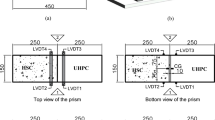Abstract
The applicability of linear elastic fracture mechanics to a composite material such as concrete has always been questioned. Recently, a new approach to describe failure of concrete has been developed. In this context a material is characterized by its fracture energy and the shape of the descending branch of the strain softening diagram. So far little work has been done to determine experimentally major influences on these material parameters. In this contribution results of test series to study the influence of age of loading, water-cement ratio, and rate of loading are presented. It is shown that a detailed evaluation of the test data necessitates appropriate computer programs. Essentials of these modules are briefly described. It is shown that failure of a beam under three-point bending mode can be predicted in a realistic way if valid material parameters are incorporated in a numerical analysis. Finally, it is pointed out that further studies are needed before a general application of the new approach can be recommended.
Similar content being viewed by others
References
Mindess, S.,The Cracking and Fracture of Concrete: An amnotated Bibliography 1928–1981, in Fracture Mechanics of Concrete, edited by F.H. Wittmann (Elsevier Science Publishers, Amsterdam, 1983).
Hillerborg, A.,Analysis of one Single Crack, ibid. Fracture Mechanics of Concrete, edited by F.H. Wittmann (Elsevier, 1983), pp. 223–249.
RILEM-Draft-Recommendation (50-FMC),Determination of the Fracture Energy of Mortar and Concrete by means of Three-Point Bend Test on notched Beams, Matér. Construct. 18 (1985) 285–290.
Roelfstra, P.E., and Wittmann, F.H.,Some Aspects of the Concept of Total Fracture Energy, inVorträge der 17. Sitzung des Arbeitskreises Bruchvorgänge, Ed. Deutscher Verband für Materialprüfung, Berlin (1985).
Rots, J.G.,Strain-Softening Analysis of Concrete Fracture Specimens, to be published inFracture Toughness and Fracture Energy (Elsevier Science Publishers, Amsterdam, 1986). [See also preprints of an International Conference on Fracture Mechanics of Concrete, Lausanne Oct. 1–3, 1985, Vol. I, pp. 115–126]
Roelfstra, P.E. and Sadouki, H.Fracture I, Theory and Applications, (Laboratory of Building Materials, Swiss Federal Institute of Technology, Lausanne, 1986).
Roelfstra, P.E., and Wittmann, F. H.,Numerical Method to Link Strain Softening with Failure of Concrete, to be published inFracture Toughness and Fracture Energy (Elsevier Science Publishers, Amsterdam, 1986)., [See also preprints of an International Conference on Fracture Mechanics of Concrete, Lausanne Oct. 1–3, 1985, Vol. I, pp. 127–137.]
Mihashi, H., and Wittmann, F. H.,Stochastic Approach to Study the Influence of Rate of Loading on Strength of Concrete, Heron (The Netherlands)25 (3) (1980).
Wittmann, F.H.,Neue Wege zur Beschreibung des Versagens von Beton (to be published).
Author information
Authors and Affiliations
Rights and permissions
About this article
Cite this article
Wittmann, F.H., Roelfstra, P.E., Mihashi, H. et al. Influence of age of loading, water-cement ratio and rate of loading on fracture energy of concrete. Materials and Structures 20, 103–110 (1987). https://doi.org/10.1007/BF02472745
Issue Date:
DOI: https://doi.org/10.1007/BF02472745




